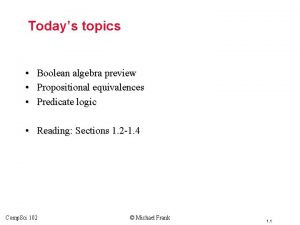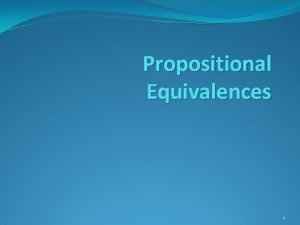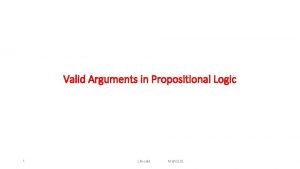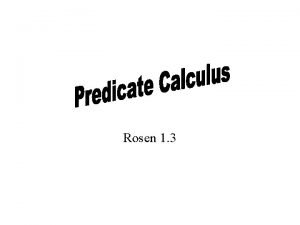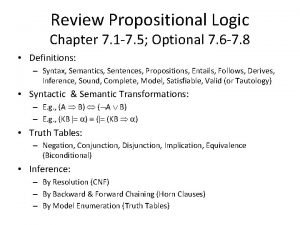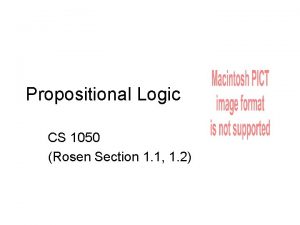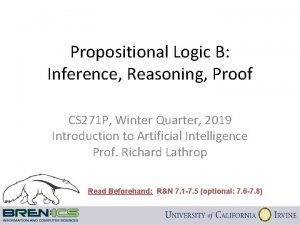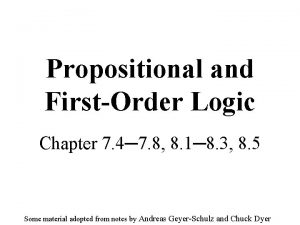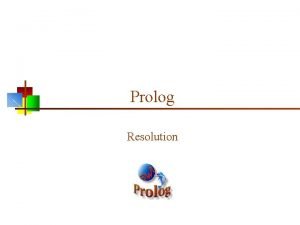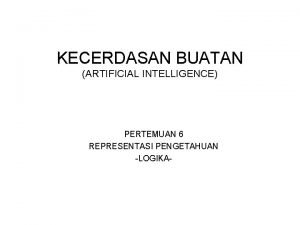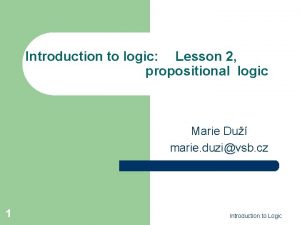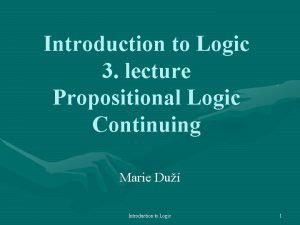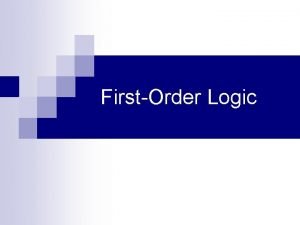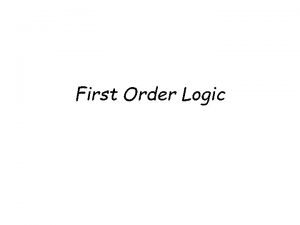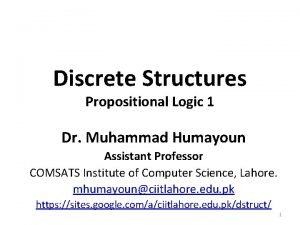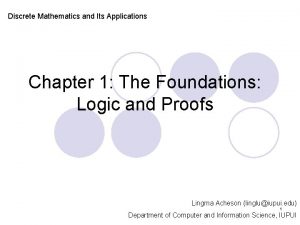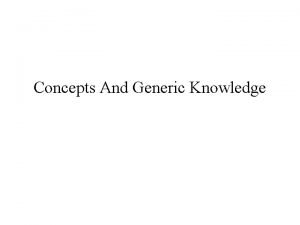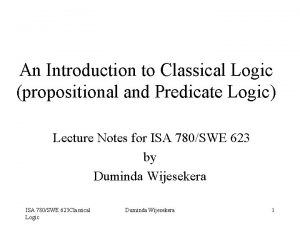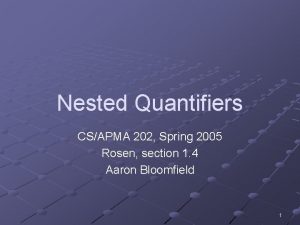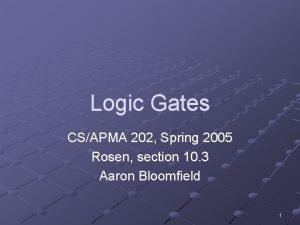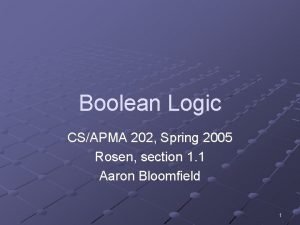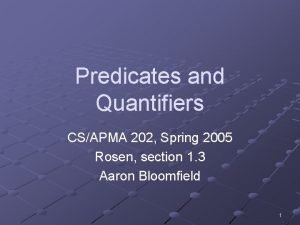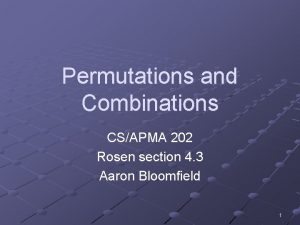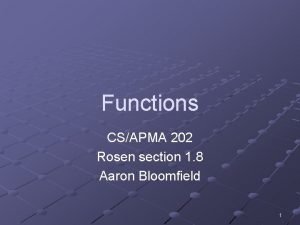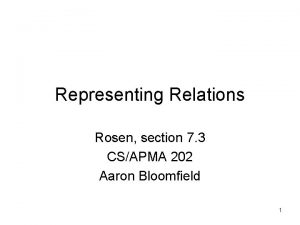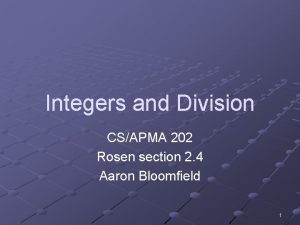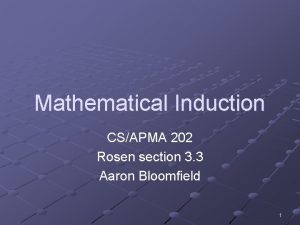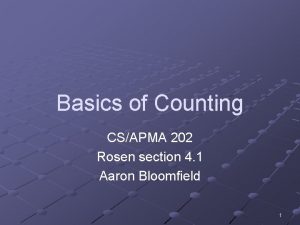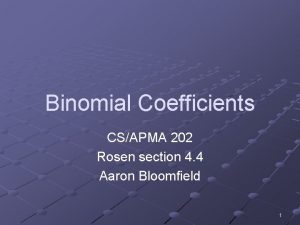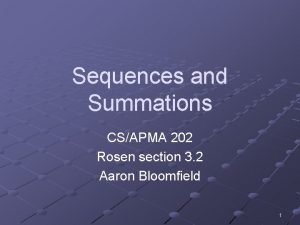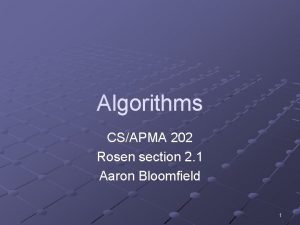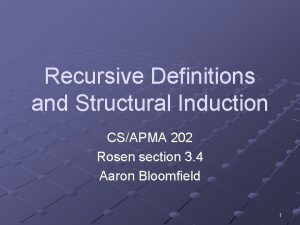Propositional Equivalences CSAPMA 202 Spring 2005 Rosen section




























- Slides: 28

Propositional Equivalences CS/APMA 202, Spring 2005 Rosen, section 1. 2 Aaron Bloomfield 1

Tautology and Contradiction A tautology is a statement that is always true n p ¬p will always be true (Negation Law) A contradiction is a statement that is always false n p ¬p will always be false p T F p ¬p T T (Negation Law) p ¬p F F 2

Logical Equivalence A logical equivalence means that the two sides always have the same truth values n Symbol is ≡ or (we’ll use ≡) 3

Logical Equivalences of And p T≡p p T F Identity law T T T p F≡F p T T F Domination law F F F p F F F 4

Logical Equivalences of And p p≡p Idempotent law p T F p q≡q p Commutative law p T T F q T F T p q T F F q p T F F F 5

Logical Equivalences of And (p q) r ≡ p (q r) Associative law p q (p q) r q r p (q r) T T T T T F T F F F F T T F F F F F F p q r 6

Logical Equivalences of Or p T≡T p F≡p p p≡p p q≡q p (p q) r ≡ p (q r) Identity law Domination law Idempotent law Commutative law Associative law 7

Corollary of the Associative Law (p q) r ≡ p q r Similar to (3+4)+5 = 3+4+5 Only works if ALL the operators are the same! 8

Logical Equivalences of Not ¬(¬p) ≡ p p ¬p ≡ T p ¬p ≡ F Double negation law Negation law 9

Sidewalk chalk guy n Source: http: //www. gprime. net/images/sidewalkchalkguy/ 10

De. Morgan’s Law Probably the most important logical equivalence To negate p q (or p q), you “flip” the sign, and negate BOTH p and q n n Thus, ¬(p q) ≡ ¬p ¬q p q p q (p q) p q TT F F T F T T T F F FT T F F T T T F F FF T T 11

Yet more equivalences Distributive: p (q r) ≡ (p q) (p r) Absorption p (p q) ≡ p 12

How to prove two propositions are equivalent? Two methods: n Using truth tables Not good for long formula In this course, only allowed if specifically stated! n Using the logical equivalences The preferred method Example: Rosen question 23, page 27 n Show that: 13

Using Truth Tables p q r p→r q →r (p→r) (q →r) p q (p q) →r T T T T T F F T F T T F F F T T T F T F T F F T T F T F F F T T T F T 14

Using Logical Equivalences Original statement Definition of implication De. Morgan’s Law Associativity of Or Re-arranging Idempotent Law 15

Quick survey n a) b) c) d) I understood the logical equivalences on the last slide Very well Okay Not really Not at all 16

Logical Thinking At a trial: n n n Bill says: “Sue is guilty and Fred is innocent. ” Sue says: “If Bill is guilty, then so is Fred. ” Fred says: “I am innocent, but at least one of the others is guilty. ” Let b = Bill is innocent, f = Fred is innocent, and s = Sue is innocent Statements are: n n n ¬s f ¬b → ¬f f (¬b ¬s) 18

Can all of their statements be true? Show: (¬s f) (¬b → ¬f) (f (¬b ¬s)) b f s ¬b ¬f ¬s ¬s f ¬b→¬f ¬b ¬s f (¬b ¬s) T T T F F T T F F F T T T F T F F F T T T F F T T F T F T T F F T T T F 19

Are all of their statements true? Show values for s, b, and f such that the equation is true Original statement Definition of implication Associativity of AND Re-arranging Idempotent law Re-arranging Absorption law Re-arranging Distributive law Negation law Domination law Associativity of AND 20

What if it weren’t possible to assign such values to s, b, and f? Original statement Definition of implication. . . (same as previous slide) Domination law Re-arranging Negation law Domination law Contradiction! 21

Quick survey n a) b) c) d) I feel I can prove a logical equivalence myself Absolutely With a bit more practice Not really Not at all 22

Logic Puzzles Rosen, page 20, questions 51 -55 Knights always tell the truth, knaves always lie A says “At least one of us is a knave” and B says nothing A says “The two of us are both knights” and B says “A is a knave” A says “I am a knave or B is a knight” and B says nothing Both A and B say “I am a knight” A says “We are both knaves” and B says nothing 23

Sand Castles 24

Functional completeness is discussed on page 27 (questions 37 -39) of the text All the “extended” operators have equivalences using only the 3 basic operators (and, or, not) n The extended operators: nand, nor, xor, conditional, bi -conditional Given a limited set of operators, can you write an equivalence of the 3 basic operators? n If so, then that group of operators is functionally complete 25

Rosen, § 1. 2 question 46 Show that | (NAND) is functionally complete Equivalence of NOT: n n n p | p ≡ p (p p ) ≡ p (p ) ≡ p Equivalence of NAND Idempotent law 26

Rosen, § 1. 2 question 46 Equivalence of AND: n n n p q ≡ (p | q ) p|p (p | q ) | ( p | q ) Definition of nand How to do a not using nands Negation of (p | q) Equivalence of OR: n n p q ≡ ( p q ) De. Morgan’s equivalence of OR As we can do AND and OR with NANDs, we can thus do ORs with NANDs Thus, NAND is functionally complete 27

Quick survey n a) b) c) d) I felt I understood the material in this slide set… Very well With some review, I’ll be good Not really Not at all 28

Quick survey n a) b) c) d) The pace of the lecture for this slide set was… Fast About right A little slow Too slow 29
 Propositional equivalences
Propositional equivalences Tautology
Tautology Du machst mich immer noch verrückt nach all jahren
Du machst mich immer noch verrückt nach all jahren Eddie rosen brian rosen
Eddie rosen brian rosen Kim ki duk summer fall winter spring
Kim ki duk summer fall winter spring Months for spring
Months for spring Propositional logic
Propositional logic Propositional network
Propositional network Propositional function examples
Propositional function examples Xor in propositional logic
Xor in propositional logic Xor in propositional logic
Xor in propositional logic Xor in propositional logic
Xor in propositional logic Propositional logic notation
Propositional logic notation Implies in propositional logic
Implies in propositional logic Propositional logic in prolog
Propositional logic in prolog First order logic vs propositional logic
First order logic vs propositional logic Propotional logic dapat digunakan untuk
Propotional logic dapat digunakan untuk Inverse implication
Inverse implication Rezolution v2
Rezolution v2 Pros and cons of propositional logic
Pros and cons of propositional logic First order logic vs propositional logic
First order logic vs propositional logic Biconditional
Biconditional Discrete math propositional logic
Discrete math propositional logic Propositional logic puzzles
Propositional logic puzzles Four components of mathematical system
Four components of mathematical system Xor in propositional logic
Xor in propositional logic Propositional networks assume that knowledge is
Propositional networks assume that knowledge is Third order logic
Third order logic Predicate logic example
Predicate logic example
